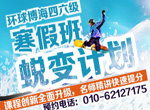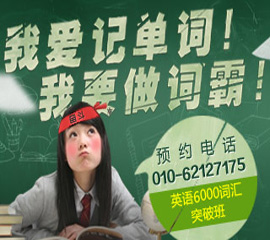2014年英语六级阅读备考训练题及答案(16)
2013-12-31 11:56:49 | 编辑:环球博海四六级 来自:网站编辑整理阅读理解主要考查对文章进行概括或总结的能力,要求在阅读短文时,能够提炼文章的中心思想,可是面对长篇阅读、选词填空以及段落匹配多题型共同组合而成的六级阅读板块,很多同学变得无所适从,没有嵌入点。环球博海四六级小编特整理了2014年英语六级阅读备考训练题及答案(16),供广大2014年的考生练习!
The founder of Honda, Soichiro Honda was a mechanical engineer with a passion for motorcycle and automobile racing. Honda started his company in 1946 by building motorized bicycles with small, war-surplus engines. Honda would grow to become the world's leading manufacturer of motorcycles and later one of the leading automakers. Following its founder's lead, Honda has always been a leader in technology, especially in the area of engine development.
Soichiro Honda was described as a maverick(特立独行的人) in a nation of conformists. He made it a point to wear loud suits and wildly colored shirts. An inventor by nature who often joined the work on the floors of his factories and research laboratories, Honda developed engines that transformed the motorcycle into a worldwide means of transportation.
Born in 1906, Honda grew up in the town of Tenryu, Japan. The eldest son of a blacksmith who repaired bicycles, the young Soichiro had only an elementary school education when, in his teens, he left home to seek his fortune in Tokyo. An auto repair company hired him in 1922, but for a year he was forced to serve as a baby-sitter for the auto shop's owner and his wife. While employed at the auto shop, however, Honda built his own racing car using an old aircraft engine and handmade parts and participated in racing. His racing career was short lived, however. He suffered serious injuries in a 1936 crash.
By 1937, Honda had recovered from his injuries. He established his own company, manufacturing piston rings, but he found that he lacked a basic knowledge of casting. To obtain it, he enrolled in a technical high school, applying theories as he learned them in the classrooms to his own factory. But he did not bother to take examinations at the school. Informed that he would not be graduated, Honda commented that a diploma was "worth less than a movie theater ticket. A ticket guarantees that you can get into the theater. But a diploma doesn't guarantee that you can make a living."
Honda's burgeoning company mass produced metal propellers during WW Ⅱ, replacing wooden ones. Allied bombing and an earthquake destroyed most of his factory and he sold what was left to Toyota in 1945.
In 1946, he established the Honda Technical Research Institute to motorize bicycles with small, war-surplus engines. These bikes became very popular in Japan. The institute soon began making engines. Renamed Honda Motor in 1948, the company began manufacturing motorcycles. Business executive Takeo Fujisawa was hired to manage the company while Honda focused on engineering.
In 1951, Honda brought out the Dream Type E motorcycle, which proved an immediate success thanks to Honda's innovative overhead valve design, The smaller F-type cub (1952) accounted for 70% of Japan's motorcycle production by the end of that year. A public offering and support from Mitsubishi Bank allowed Honda to expand and begin exporting. The versatile C100 Super Cub, released in 1958, became an international bestseller.
In 1959, the American Honda Motor was founded and soon began using the slogan, "You meet the nicest people on a Honda," to offset the stereotype of motorcyclists during that period. Though the small bikes were dismissed by the dominant American and British manufacturers of the time, the inexpensive imports brought new riders into motorcycling and changed the industry forever in the United States.
Ever the racing enthusiast, Honda began entering his company's motorcycles in domestic Japanese races during the 1950s. In the mid-1950s, Honda declared that his company would someday win world championship events--a declaration that seemed unrealistic at the time.
In June 1959, the Honda racing team brought their first motorbike to compete in the Isle of Man Tourist Trophy race, then the world's most popular motorcycle race. This was the first entry by a Japanese team. With riders Naomi Taniguchi, who finished sixth, Teisuke Tanaka, who finished eighth, and Kiyoshi Kawashima, who would later succeed Soichiro as Honda Motor president, as team manager, Honda won the manufacturer's prize.
However, they were not pleased with their performance. Kawashima remembers: "We were clobbered. Our horsepower was less than half that of the winner."
Learning from this experience, Soichiro and his team worked even harder to make rapid progress in their motorsports activities. Two years after their first failure, they were the sensation at the TT by capturing the first five places in both the 125ce and 250cc classes. The upstart Japanese had outclassed all their rivals. As a result of the team's stellar performance, the Honda name became well known worldwide, and its export volume rose dramatically. Soichiro seemed to have foreseen the future of Japan, which, twenty years later, was to become one of the world's leading economies.
Honda would become the most successful manufacturer in all of motorcycle racing. Honda has since won hundreds of national and world championships in all forms of motorcycle competition.
While Honda oversaw a worldwide company by the early-1970s (Honda entered the automobile market in 1967), he never shied away from getting his hands greasy. Sol Sanders, author of a Honda biography, said Honda appeared "almost daily" at the research lab where development work was being done. Even as president of the company, "he worked as one of the researchers,' Sanders quoted a Honda engineer as saying. "Whenever we encountered a problem, he studied it along with us."
In 1973, Honda, at 67, retired on the 25th anniversary of Honda's founding. He declared his conviction that Honda should remain a youthful company. "Honda has always moved ahead of the times, and I attribute its success to the fact that the firm possesses dreams and youthfulness," Honda said at the time.
Unlike most chief executive officers in Japan, who step down to become chairmen of their firms, Honda retained onty the title of "supreme adviser". In retirement, Honda devoted himself to public service and frequent travel abroad. He received the Order of the Sacred Treasure, first class, the highest honor bestowed by Japan's emperor. He also received the American auto industry's highest award when he was admitted to the Automotive Hall of Fame in 1989. Honda was awarded the AMA's highest honor, the Dud Perkins Award, in 1971.
Honda died on August 5, 1991 from liver failure at 84. His wife, Sachi, and three children survived him.
1. Soichiro Honda was a man who preferred to wear plain clothes.
2. When enrolled in a technical high school to obtain basic knowledge of casting, Soichiro Honda finally got the diploma after attending the examinations.
3. Like most chief executive officers in Japan, Soichiro Honda Stepped down to become chairmen of Honda after his retirement.
4. Even as the president of a worldwide company, Soichiro Honda would work at the research lab with the employees.
5. Following its founder's lead, Honda has always been a leader in technology, especially in the area of ______.
6. After WW Ⅱ, Honda mounted ______ on bicycles and these motorized bicycles sold rapidly in Japan.
7. A public offering and support from ______ allowed Honda to expand his business and begin to invade the international market.
8. In 1959, the American Honda Motor used the slogan," ______" to change the negative image of motorcyclists in America.
9. In 1959 with their first motorbike Honda racing team participate in ______ race, which was the most popular motorcycle race at that time.
10. According to Honda, ______ are, the major factors that led to the success of Honda company.
1. N 2. N 3. N 4. Y
5. engine development
6. small, war-surplus engines
7. Mitsubishi Bank
8. You meet the nicest people on a Honda.
9. the Isle of Man Tourist Trophy
10. dreams and youthfulness
以上是小编为2014年6月份备考的广大考生准备的英语六级阅读训练题,俗话说,磨刀不误砍柴功,重在平时积累。考生们,为了你们的通行证书,加油吧,祝你们在2014年的英语四六级考试中一举夺冠!
环球博海四六级栏目针对广大考生学习情况特推出网络课程、四六级寒假班以及6000词汇突破班等,以及环球博海四六级官方频道的YY讲堂,权威名师悉心指导,让你的学习打破常规壁垒、突飞猛进。



![6M1EBPMKUCI~A)%0SXXYM]I.jpg](http://file1.gedu.org/9f3ac1eb-1f23-46a2-a1cf-597d3f00ce37/2013/1231/ecb50e3c-19fd-4aed-8fcd-b6cefe3bb96c.gif6fd54bde-dbbf-487c-8deb-270b765e7130.jpg)


















